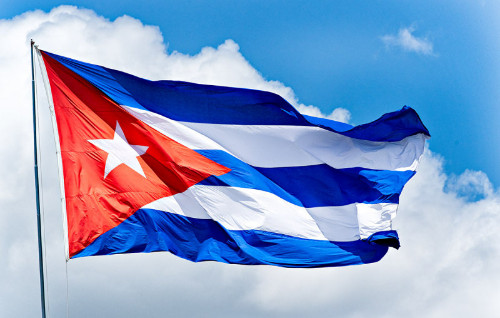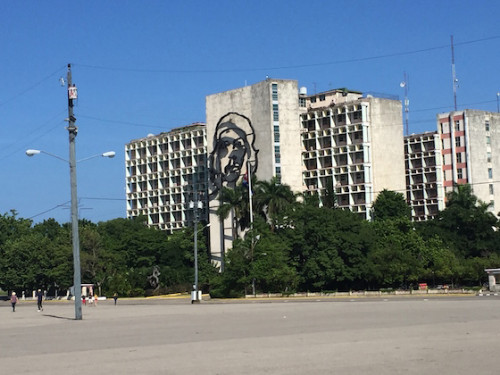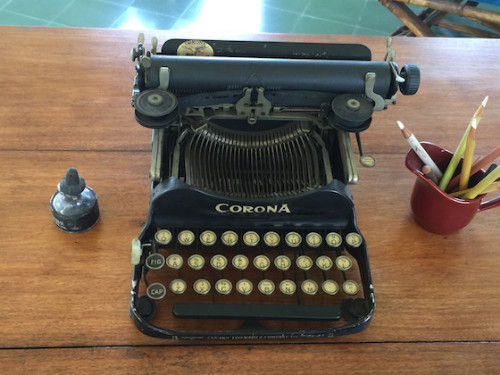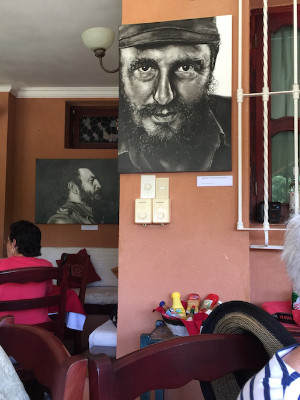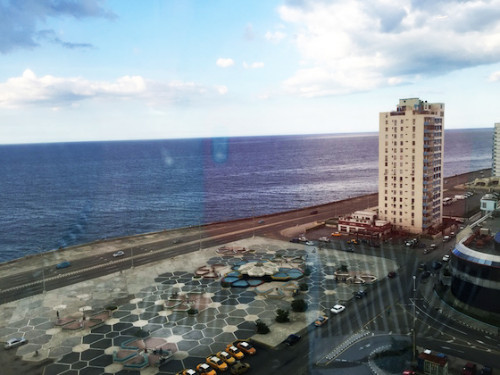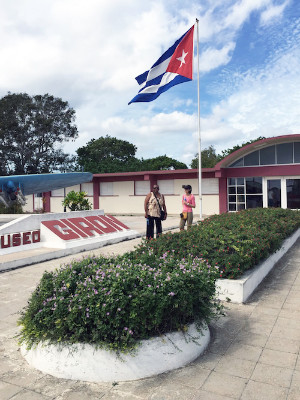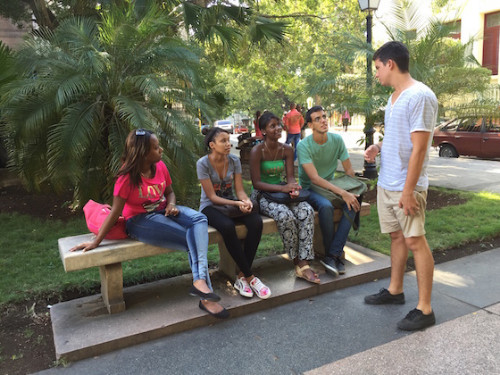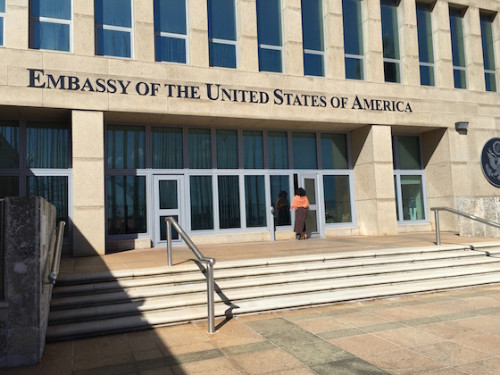A Week in Cuba
Have a Havana
By: Nancy Bishop - Nov 19, 2015
Cuba has always seemed a land of mystery, glamour, music and passion. The desire to visit lurked on the edges of my memory as I read books like The Mambo Kings Play Songs of Love (by Oscar Hijuelos), Dreaming in Cuban (Cristina Garcia), To Have and Have Not (Ernest Hemingway) and Los Guisanos (John Sayles). Films like Our Man in Havana, The Mambo Kings, Before Night Falls and even Chico and Rita, the 2010 animated film, enhanced my yearning for this exotic city. So I had my vision of Havana and Cuba and somehow, it took many decades before I finally achieved my Cuba dream.
I spent last week in Cuba with a group of about 30 charming and interesting travelers as part of a Smithsonian Journeys tour. The week was fascinating and intellectually invigorating while also being tiring and enervating. Cuba is beautiful, its people are warm and welcoming, and its economy and infrastructure are in desperate need of investment and some good old capitalism. Here are my thoughts after being home for a few days.
We may have renewed diplomatic relations with Cuba but the trade and travel embargo are still in place. You can’t go to Cuba by buying a ticket from Miami to Havana. US citizens risk prosecution if they travel directly to Cuba until Congress lifts the trade embargo, which requires action. (Congressional action; that would be an oxymoron.) You can travel to Cuba now with an educational or “people to people” mission, organized by a licensed tour organization.
Besides your passport, you need a tourist visa to travel to Cuba. There’s a rumor that a bootleg trip to Cuba wouldn’t be tracked because the Cuban immigration officials don’t stamp your passport. That may have been true in the past, but our passports were all stamped on arrival and departure at Jose Marti International Airport.
Smithsonian Journeys arranged our trip and all arrangements were managed extremely well. The Smithsonian tour manager (the saintly Claire) was extremely competent and attentive to our needs and schedule. Our local tour guide was Yoandry, a Cuban charmer who is very well informed but never strays from the party line. In addition, Enrique, an emeritus professor of Spanish from the University of New Mexico, was our study expert. Bernardo was our bus driver and maneuvered floods, 500-year-old cobblestone streets, and Havana traffic with skill. The coach in which we traveled around Cuba (far too much coach time) was comfortable, air-conditioned and equipped with vast quantities of bottled water.
About half of the cars on Havana streets are beautiful old cars from the 1950s, most of them shiny and cared for. There are many new cars now too, however, especially Kias and Toyotas.
Cuba’s infrastructure is sorely lacking and they are definitely not ready for a flood of tourists, should the US travel embargo be lifted. Water and sanitation are serious problems. You can’t drink the water anywhere, many toilets don’t flush and you can’t put paper in the toilets. (At toilets outside the big cities, you typically are greeted by an attendant who hands you a wee scrap of toilet paper and then flushes the toilet with a bucket of water. You clean your hands with hand sanitizer.)
The climate is tropical, of course, and hotter than I expected. Beastly humid and hot, in fact. Hats and sunscreen are required as is bug spray in many places. Very few buildings have elevators or air-conditioning. (Our hotels had both.)
Cuba has little or no internet access so my smartphone was used as a camera only. It is possible to buy internet cards and get spotty reception at hotels, but I had decided I was just going to put my phone on airplane mode for the week.
The itinerary
We arrived in Havana early on a Saturday morning. The Havana airport is a zoo and I was happy to have Claire guiding us through the maze and people swarms. We spent three days and nights at the Melia Cohiba, a luxury hotel in Havana, then drove three hours to Cienfuegos, where we spent two days, including a side trip to Trinidad, the 500-year-old city. Finally, we drove back to Havana for a final night in a state-run hotel and departure the next day for Miami. Along the way, we made stops at sugar cane facilities, museums and the Bay of Pigs invasion site. (Yes, really.)
Tour highlights
I’ll just say that the only time we spent on the beach was at the Bay of Pigs invasion site. Trust me, this was not a resort vacation. See travel embargo above.
Ernest Hemingway’s estate in Finca Vigia, just outside Havana. We were able to walk around the house but mainly peer in to the rooms through windows and doors. I also walked up the stairs of his “writing tower” to see the room where he wrote For Whom the Bell Tolls and The Old Man and the Sea. The docent was kind enough to take photos for me, including the priceless shot of his typewriter.
A walking tour of Old Havana with a local architect, including a glimpse of the 1930 Bacardi building, a gorgeous art deco structure. We also visited Hemingway’s room in the Pink Hotel, where he lived with his then-wife, Martha Gellhorn, for seven or eight years. It’s on the fifth floor but the building has one of those cage-like old elevators. Hem got his exercise every day, going in and out to have lunch and drink daiquiris at the bar in Café Ambos Mundes.
I have now visited five of Hemingway’s homes. I’ve visited his childhood home in Oak Park, his Key West home and I regularly walk by the building at 1239 North Dearborn Street where he lived in Chicago with his wife Hadley in 1921 (on the fourth floor of a 19th century row house, now a single family home).
A tour of the University of Havana (founded in 1728 by the Dominicans) with Yoandry and university administrator Nestor as our guides. We met in the Aula Magna, the great hall, in the oldest building for a briefing and then walked around the campus. The university has about 12,000 students who receive their five-year undergrad educations and all services at no cost.
A briefing at the US Embassy with the impressive political chief, Justin Davis. He gave us a good overview of the current Cuban political and economic situation and US legislation that restricts trade and travel. The embargo not only restricts investment by US companies; it prohibits any company that invests in Cuba from investing in the US.
Cuba imports 80 percent of its foodstuffs, much of it from the US (agricultural products are excluded from the embargo) and most of its oil from Venezuela. Cuba exports only rum and cigars. About $2 billion of Cuba’s GDP is made up of remittances from Cuban-Americans. The average wage for a government worker is $25/month. He also discussed the political situation given the advanced ages of the Castro brothers. Raul Castro has said he will step down in 2018. The Cuban constitution allows only the Communist Party to stand for election. The likely successor to the Castros is the first vice minister, Miguel Diaz Canel.
An economic briefing from a professor of economics at the University of Havana. I wasn’t expecting to hear economic data that contradicted government positions, but he needed speaker training. He read all the bulletpoints on his slides, with his back turned to the audience. Among the humorous things he said were claiming a 3.8% unemployment rate and a 4.1% projected growth in GDP. (The embassy official cited 2.4% as the projected 2015 growth.)
A meeting at Cuba Emprende, a church-supported nonprofit that trains and advises entrepreneurs. Raul Castro has loosened restrictions on private business and there is evidence of small business activity—especially in the paladars or privately owned restaurants and hostels—and this group offers workshops and advice for startups. We had a chance to visit a classroom where about 30 students were just beginning their four-week workshop on how to start and run a business. Most of them were starting small service businesses and many were hoping for capitalization, which is very difficult. Most entrepreneurs need their own savings or family money to get started.
Visits to artists’ studios and shops in Havana and Cienfuegos and the Museum of Fine Arts in Havana. (I’ll write about the art and music scene in my next post, Cuba: Part 2.
A dinner and jazz concert at a magnificent private home filled with art and beautiful Cuban and Spanish antiques. (Clearly Cuba has its 1% elite population.)
A briefing on the beach at the Bay of Pigs invasion site and a tour of the nearby Playa Giron Museum. I have absolutely no doubt that the CIA planned and botched the Bay of Pigs invasion and it was interesting to hear about it from a Cuban point of view. The museum was filled with captured American weapons, photos, maps and humorous propaganda on the bilingual exhibit legends.
Farewell dinner. On our final night, we left the Hotel Nacional for our farewell dinner, expecting to be transported by our HavanaTur coach number 3779. Instead, a fleet of gorgeous 1950s convertibles was waiting for us and we cruised around the city like locals to the paladar where we dined. I rode with Miguel in a 1959 blue Ford convertible. On another occasion, I had a taxi ride in a 1973 Lada, with no window glass or seatbelts. The driver called it his Russian jalopy.
The Cuban people
May I say the Cuban people are beautiful? The men are handsome at every age and the women are equally beautiful. They are warm and welcoming without exception and those who speak a little English like to talk to Americans.
Yoandry, our local guide, has a bachelor’s degree in Russian studies from the University of Havana (because Russian was what was on offer when he went to school) and speaks quite good English. He’s very well-informed on Cuban history and fairly well informed on economic matters. He brought his girlfriend to our farewell dinner and they share the career goal of being tourist guides, for which they earn about 30 CUCs (about US$30) a month. (The CUC is the Cuban convertible currency, which is tied to the US dollar in a one-to-one relationship. There’s also the national peso, a local currency, which tourists cannot use.)
The food
Do not go to Cuba for the cuisine. Hotel breakfasts were okay and we ate all our other meals in paladars, many of which are in remodeled private homes. A few of the meals included tasty entrees or soups, but for the most part, the food is bland and boring. The typical menu is black beans, rice, and a choice of sliced pork, beef or chicken. Occasionally fish or lobster was served and one night I had a flavorful lamb stew. With black beans and rice.
The Cubans don’t seem to have any herbs or vegetables for seasoning and don’t use much salt. About the middle of the week, I decided to ask for hot sauce (“Tiene usted salsa picante?”) and that improved the black beans considerably.
Some people thought the food would be spicy but I had been to Cuban restaurants in Chicago so I knew what kind of a menu we would have.
I was obsessive about not eating or drinking anything that would make me sick (having had a dreadful experience once in Mexico), so I drank only bottled water (as recommended), drinks sin hielo (and I love my ice), and no uncooked vegetables or unpeeled fruit. Liquor flowed freely and mojitos or other cocktails were routinely served at lunch and dinner; beer and wine were usually available too. Espresso was usually good but regular coffee was mediocre. I usually drank warm bottled water and was glad to get home to iced coffee and iced tea.
Government, politics and the economy: Cuba’s future
The end of the Castro reign over Cuba probably will not mean much change, given the governmental structure. Images of Che are everywhere and he’s clearly a national hero, 48 years after his death. There’s Fidelismo too, but images of Che predominate. There’s no reason to be optimistic about political liberalization.
However, the US trade embargo will probably be lifted in the next few years. The question is what kind of investment will result. I just hope that hundreds of golf courses don’t pop up on all that vacant farm land. But more foreign investment and more foreign visitors may well change the mindset and improve the financial wellbeing of the Cuban people.
Cuba, of course, does not have freedom of speech or press. Right now, access to the open internet in Cuba is limited to about 5% of the population, nearly the lowest in the world. Investment is sure to bring better telecommunications and internet functionality. But will the government allow Cubans to access world news and use social media to communicate? The likelihood of a “Cuban spring” is low, it seems to me.
Land of hope and dreams?
Some Bruce Springsteen song is always playing in my head. Last week it was “Land of Hope and Dreams,” a classic train song, with lyrics like this:
This train, carries saints and sinners
This train, carries losers and winners
This train, carries whores and gamblers
This train, carries lost souls
This train, dreams will not be thwarted
This train, faith will be rewarded
And this refrain:
Big wheels roll through fields
Where sunlight streams
Meet me in a land of hope and dreams.
I feel that my week in Cuba was visiting a land of hope and dreams, but I’m not optimistic about when the Cuban peoples’ dreams will come true.
Reposted from the blog of Nancy Bishop.

